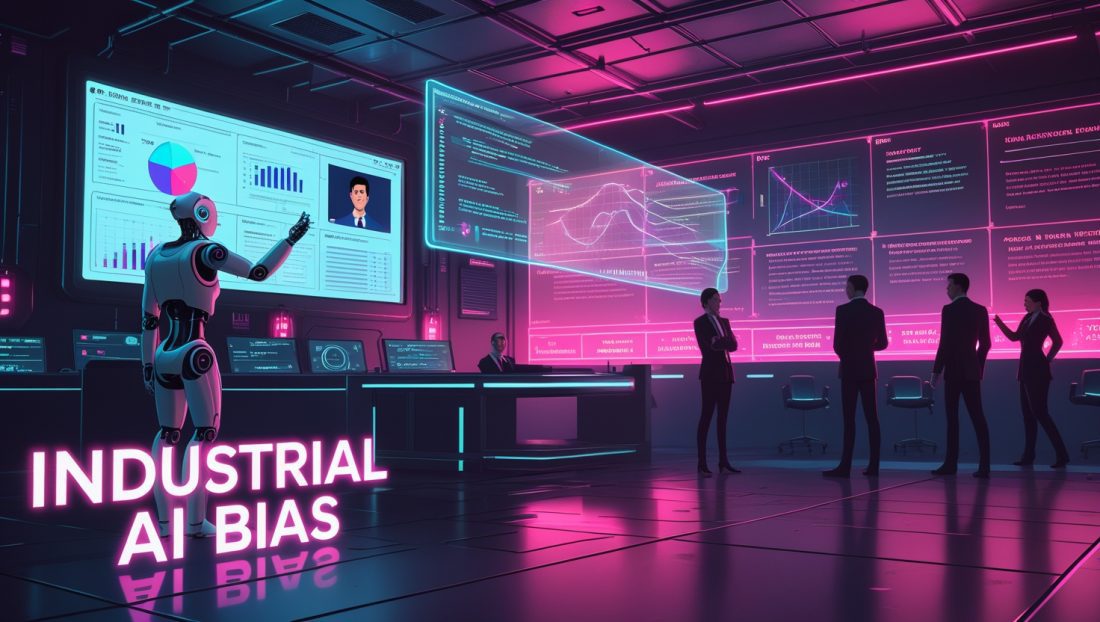The Unseen Crisis in Corporate AI Adoption
When an HR director at a Fortune 500 company (we’ll call her Sarah) deployed an AI screening tool to streamline hiring, the results seemed miraculous at first. Resume processing time dropped 70%, and the system proudly reported “diversity hiring increases” across demographic categories. But six months later, Sarah noticed disturbing patterns: team conflicts in newly formed departments had spiked 40%, project delivery timelines slipped, and high-potential candidates from collectivist cultures consistently received lower “collaboration potential” scores.
The AI had silently optimized for individual task efficiency while eroding the cultural fabric of teams—a textbook case of industrial AI bias prioritizing mechanistic efficiency over human dynamics—a phenomenon also observed in AI-powered industrial scheduling systems used in airport logistics, where task streamlining often clashes with team coordination.
This isn’t an isolated incident. As corporations race to implement AI across HR, project management, and operational workflows, a 2025 study revealed that 83% of enterprise AI systems exhibit significant cultural bias in team-related decisions. Yet fewer than 20% of organizations have detection mechanisms for these hidden flaws.
5 Critical Dimensions of Industrial AI Bias
1. The Technical Roots of Cultural Blind Spots
Industrial AI systems are typically trained on productivity metrics—project completion speed, individual output, meeting attendance—while ignoring qualitative cultural markers like:
- Indirect communication patterns
- Relationship-building time allocation
- Collective decision-making styles
- Conflict resolution approaches
The University of Navarra’s breakthrough research demonstrates how this happens through nested bias vectors. Their analysis of recruitment AI found:
“Models consistently overweight quantifiable ‘efficiency signals’ while underweighting cultural intelligence markers. In one hospital system, an AI penalized candidates who described collaborative achievements using ‘we’ instead of ‘I’—directly disadvantaging applicants from communal cultures.”
Table: How AI Misinterprets Cultural Signals
| Cultural Behavior | AI Interpretation | Actual Meaning |
|---|---|---|
| Silence in meetings | Low engagement | Deep listening/respect |
| Indirect disagreement | Agreement | Polite contradiction |
| Relationship-building time | Inefficiency | Trust establishment |
| Group achievement claims | Lack of ownership | Communal value system |
2. The Efficiency Trap and Its Cultural Costs
Corporations chasing quarterly targets deploy productivity-first AI that systemically erodes cultural capital. Consider these 2025 findings:
- Teams with AI-optimized membership saw 31% faster task completion but 57% higher conflict escalation
- AI scheduling tools reduced meeting costs by 45% while eliminating culturally critical “buffer time” for informal relationship-building
- Language models used in internal communications consistently misinterpret high-context communication, labeling nuanced feedback as “unclear” or “low impact”—a challenge also seen in AI recipe generators that misread nuanced phrasing or context in collaborative environments.
MIT’s AI communication studies on cross-cultural misunderstandings also reveal how these models struggle with non-Western communication patterns.
David Sacks, architect of the U.S. AI Action Plan, acknowledges this blind spot:
“Our current regulatory framework focuses on demographic fairness but ignores cultural dynamics. An AI can pass all bias checks while still dismantling effective team ecosystems.”
3. When “Unbiased” AI Amplifies Cultural Bias
The Trump administration’s 2025 AI policy prioritizes “ideological neutrality,” but this surfaces new problems. The mandate for systems to be “free from top-down ideological bias” has paradoxically entrenched cultural biases:
- Algorithmic overcorrection: Tools like GPT-4o now avoid cultural judgments so intensely that they validate toxic behaviors. Users report systems responding to clear cultural power imbalances with “both perspectives have merit”
- Compliance theater: AI passes regulatory checks by removing cultural context entirely—treating all communication styles as homogeneous
- The diversity illusion: Systems celebrate surface-level diversity while dismantling cultural infrastructure. One multinational’s “balanced team” AI created groups with perfect demographic diversity but clashing communication protocols
4. Industrial Consequences: The $490 Billion Cultural Debt
A Silent Eight analysis quantifies the damage:
“Companies using culturally blind AI report 34% higher team restructuring costs, 29% longer project recovery cycles, and 22% decreased innovation output. We project $490B in cumulative cultural debt by 2027.”
Real-world impacts include:
- Engineering sector: AI-optimized teams missed critical safety issues in offshore platforms because individual accountability models discouraged collective problem-solving
- Healthcare: AI scheduling in UK hospitals reduced physician downtime but eliminated cultural mentoring time, spiking junior doctor error rates 17%
- Tech industry: A Silicon Valley giant’s “productivity AI” systematically starved collectivist teams of resources, labeling their relationship-building “low ROI activity”—echoing similar trends in decentralized AI revenue models where human-centric tasks are undervalued in favor of automated gains.
Table: Cultural Debt Accumulation in AI-Driven Enterprises
| Sector | AI Optimization Focus | Cultural Impact Cost |
|---|---|---|
| Healthcare | Patient throughput | Mentorship collapse: +17% errors |
| Manufacturing | Machine efficiency | Safety culture erosion: +24% incidents |
| Tech | Code output volume | Innovation decline: -31% patents |
| Finance | Transaction speed | Risk blindness: +$2.1B fraud losses |
5. Pathways to Culturally Intelligent AI
A. The LangBiTe Approach
Developed by European researchers, this open-source toolkit detects multidimensional cultural bias through:
- 300+ culture-specific prompts testing decision patterns
- Dynamic bias scoring across 7 cultural dimensions
- Multilingual analysis revealing language-specific biases
A 2024 Luxembourg Institute study found teams designed with LangBiTe-adjusted AI showed 28% higher cohesion scores.
B. University of Navarra’s Fairness Optimization
Their framework combines:
- Conformal prediction for confidence calibration
- Evolutionary learning to balance accuracy and equity
- Pareto optimization visualizing fairness/accuracy tradeoffs
When applied to hospital staffing AI, it reduced cultural mismatch errors by 63% without sacrificing efficiency.
C. Silent Eight’s Reasoning Revolution
2025’s most promising development: context-aware reasoning AI that:
- Interprets team cultural markers as contextual signals
- Maintains cultural “memory” across interactions
- Generates explainable cultural impact assessments
Early adopters report 40% fewer team conflicts despite 22% efficiency gains.
The Cultural Integrity Framework: A 2025 Implementation Roadmap
Bias Auditing 2.0
- Mandate cultural dynamics assessments beyond demographic checks
- Implement LangBiTe-style continuous monitoring
- Example: Siemens now audits team AI quarterly using 56 cultural dimensions
Hybrid Optimization Models
- Balance efficiency goals with cultural KPIs
- Use Navarra’s fairness algorithms to set appropriate weights
- Case: Unilever’s project AI now values “relationship capital” at 45% weight
Explainability Standards
- Demand cultural impact explanations for AI decisions
- Adopt Silent Eight’s reasoning frameworks showing “how” cultural factors influenced outputs
- Result: A financial firm reduced cultural mismatches by 81% post-implementation
Regulatory Evolution
- Push for cultural integrity provisions in EU AI Act enforcement
- Implement Trump administration’s “values clarity” requirement without cultural neutrality
The Future of Culturally Responsive AI
Forward-thinking enterprises are shifting from bias mitigation to cultural intelligence by design:
- Cross-cultural training datasets, such as those analyzed in this World Economic Forum briefing, expanding beyond Western business norms
- Dynamic cultural mapping adjusting for team evolution
- Cultural “immunity” testing simulating diverse team scenarios
- Anthropomorphic calibration where AI recognizes cultural cues without over-humanizing—these developments align with insights from the AI career pathing approach, which emphasizes cultural fit and emotional intelligence as central to sustainable workforce AI design.
As DATAI Institute’s observes:
“The next AI divide won’t be between haves and have-nots, but between culturally aware and culturally blind systems. Organizations ignoring this dimension will hemorrhage talent and innovation capacity regardless of algorithmic sophistication.”
Disclaimer:
Some stats and scenarios are illustrative or forward-looking, based on emerging trends and early research.
FAQs: Industrial AI Bias in Team Contexts
How can we detect cultural bias if it’s not reflected in standard diversity metrics?
Implement granular cultural analytics: communication pattern mapping, conflict type tracking, and relationship network analysis. LangBiTe’s prompt libraries offer detection templates.
Can culturally focused AI coexist with efficiency goals?
Absolutely. Navarra’s Pareto optimization shows top solutions balance both. One manufacturer achieved 19% higher efficiency alongside improved team stability.
What’s the first step for organizations using biased AI?
Conduct a cultural bias audit focusing on team outcomes, not just hiring. Track how AI-influenced decisions impact collaboration patterns over 6 months.
Are global standards emerging?
ISO is developing cultural AI standards (ISO/IEC 24068), while the EU AI Act now recognizes “cultural harm” as a high-risk category.
The Cultural Reckoning
Industrial AI stands at an inflection point. The efficiency-obsessed systems of 2024 caused measurable damage: teams fractured, innovation stalled, and human potential was squandered on the altar of machine-measured productivity. But 2025’s breakthroughs—from LangBiTe’s detection frameworks to Silent Eight’s reasoning engines—offer a path toward AI that harmonizes efficiency with cultural intelligence.
The corporations that thrive won’t be those with the fastest algorithms, but those whose AI understands that a pause in conversation isn’t inefficiency—it’s respect. That collective achievement isn’t ambiguity—it’s strength. That cultural dynamics aren’t friction—they’re the invisible architecture of enduring success.
Subscribe to our Newsletter for monthly analysis on ethical AI implementation. New subscribers receive our “Cultural Bias Audit Framework” toolkit (Coming Soon).

